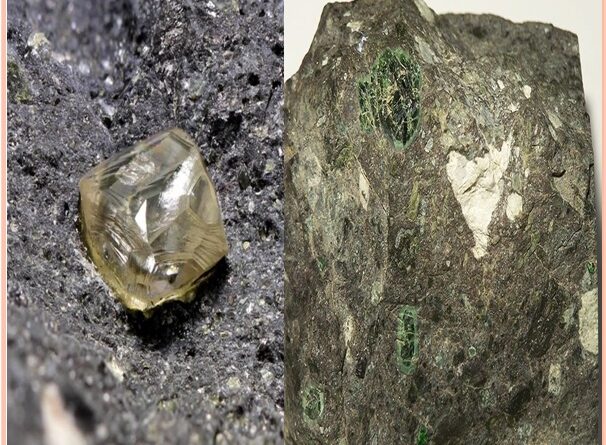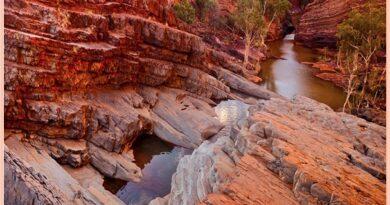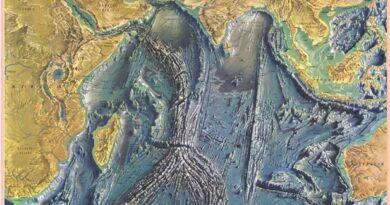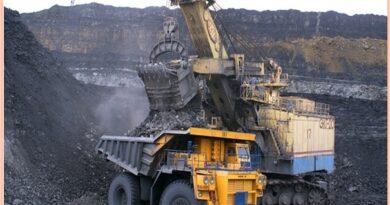Diamond Bearing Kimberlite Rocks-Morphology and Composition
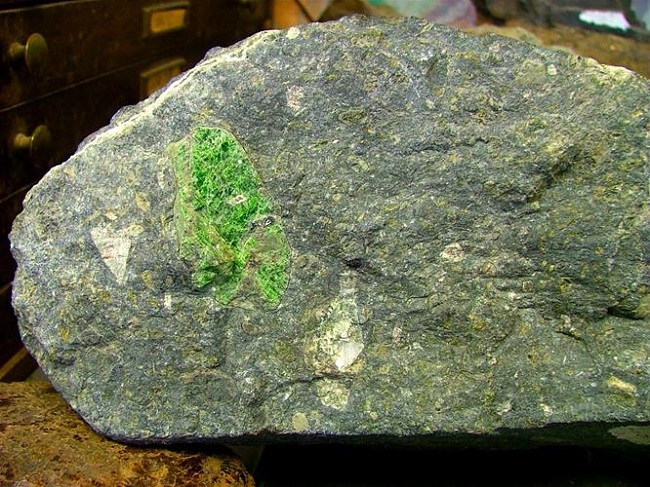
Currently, diamonds are extracted from both kimberlites and lamproites and most exploration activity for diamonds is directed toward the discovery of further exploitable deposits in these rocks. Kimberlite rock provides excellent information about the composition of the deep mantle and melting processes occurring at or near the boundary between the cratonic continental lithosphere and the underlying convecting asthenospheric mantle.
Morphology of Kimberlite Rocks
Kimberlites are magmatic rocks that form deep in Earth’s interior and are brought to the surface by volcanic eruptions. On their turbulent journey upwards magmas assimilate other types of minerals, collectively referred to as xenoliths. The xenoliths found in kimberlite include diamonds, and the vast majority of the diamonds mined in the world today are found in kimberlite ores. Most known kimberlites formed in the period between 70 and 150 million years ago, but some are over 1200 million years old. Generally, kimberlites are found only in cratons, the oldest surviving areas of continental crust, which form the nuclei of continental landmasses and have remained virtually undisturbed since their formation millions of years ago. Kimberlitic magmas form about 150 km below Earth’s surface, at much greater depths than any other volcanic rock.
The temperatures and pressures at such depths are so high that carbon can crystallize in the form of diamonds. When Kimberlitic magmas are forced through long Funnel-shaped pipes of volcanic origin, their velocity markedly increases and the emplaced diamonds are transported upwards into the surface. This is why kimberlite pipes are the sites of most of the world’s diamond mines. But diamonds are not the only passengers. Kimberlites also carry many other types of rock with them on their long journey.
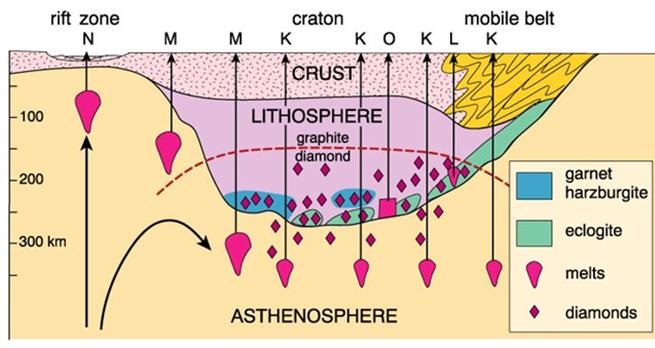
Kimberlite magmas travel fast and emerge onto Earth’s surface as explosive eruptions. the volatile gases such as carbon dioxide and water vapor play an essential role in providing the necessary buoyancy to power the rapid rise of kimberlite magmas. The assimilated rocks picked up along the way are responsible for providing the required impetus. The primordial magma is basic, but the incorporation of silicate minerals encountered during its ascent makes the melt more acidic. This leads to the release of carbon dioxide in the form of bubbles, which reduce the density of the melt, essentially causing it to foam. The net result is an increase in the buoyancy of the magma, which facilitates its continued ascent.
How Kimberlite Rock Forms
Kimberlite Rocks formed deep within the mantle, at depths between 150 and 450 kilometers, from anomalously enriched mantle compositions. They are erupted rapidly and violently, often with the release of considerable amounts of carbon dioxide (CO2) and volatile components. The violent explosions produce vertical columns of funnel shape volcanic pipes or kimberlite pipes, that rise from the magma reservoirs. The depth of melting and the process of magmatism make kimberlites prone to hosting diamond xenocrysts.
The morphology of kimberlite pipes is varied, Generally includes a sheeted dike complex of vertically dipping feeder dikes in the root of the pipe, extending down to the mantle. Within 1.5-2 kilometers of the surface, as the magma explodes upward, it expands to form a conical to the cylindrical zone called the diatreme. The diameter of a kimberlite pipe at the surface is typically a few hundred meters to a kilometer. Many kimberlite pipes are believed to have formed about 70 to 150 million years ago, but in Southern Africa, there are several that formed between 60 to 1,600 million years ago.
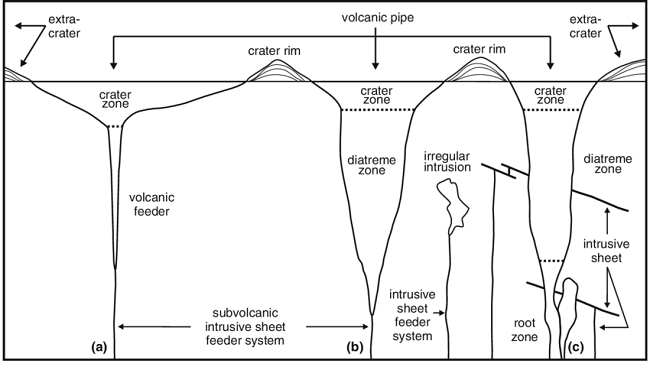
Kimberlite Rocks Emplacement Models
There are three types of Kimberlite emplacement models-
Explosive volcanism theory
Magmatic (fluidization) theory
Hydrovolcanic theory
Explosive Volcanism Theory
This theory involves the pooling of kimberlite magma at shallow depths, When the pressure within this pocket, termed an intermediate chamber, is sufficient to overcome a load of rocks the eruption has occurred. The epicenter of the eruption was believed to be at the diatreme facies contact. However, this theory is not relevant, because no intermediate chamber has been found at depth.
Magmatic Theory
This theory says that Kimberlite magma rises from depth with different pulses building termed as “embryonic pipes”. Escape at some point the embryonic pipes reach a shallow enough depth. Whereby the pressure of the volatiles is able to overcome the load of the overlying rocks. As the volatiles are escaping, a brief period of fluidization occurs. Fluidization is believed to be short-lived as fragments are commonly angular.
Hydrovolcanic Theory
The theory evolved that Kimberlites magmas rise from depth through narrow 1m thick fissures. The kimberlite magma is focused along structural faults which act as focuses for waters or resultant brecciation due to volatile exsolution from the rising kimberlites may act as a focus for water. The brecciated rock becomes recharged with groundwater. Another pulse of kimberlite magma follows some structural weakness in the rock to surface and again comes in contact with water producing another explosion.
Kimberlite Composition
Historically, kimberlites have been classified in two different varieties on the basis of petrographic observation the kimberlite is the basaltic and “micaceous” origin of the Kimberlite.
Kimberlite
Kimberlites rocks are of CO2-rich ultramafic potassic igneous rocks dominated by primary forsterite olivine and carbonate mineral. It also has some trace-mineral assemblage of magnesian ilmenite, chromium pyrope, almandine-pyrope, chromium diopside, phlogopite, enstatite, and Ti-poor chromite.
Olivine Lamproites
Olivine lamproites only occurred in South Africa. Olivine lamproites are ultrapotassic, peralkaline rocks rich in volatiles with dominantly H2O. The distinctive characteristic of olivine lamproites is phlogopite macrocrysts and microphenocrysts.
Also read- The Serpent Rock-“Ophiolite”, Its Origin, and Evolution
Kimberlite indicator minerals
Kimberlites in igneous rocks because they contain a variety of minerals that indicate they formed under high pressure and temperature within the mantle. These minerals, such as chromium diopside, chromium spinels, magnesian ilmenite, and pyrope garnets are generally absent from most other igneous rocks and this property makes them particularly useful as indicators for kimberlites.
Economic importance of Kimberlite Rocks
Kimberlite rocks and Lamproits have tremendous economic importance because they are host rocks for gem and industrial-grade diamonds. Kimberlites & lamproites are known from scattered localities throughout the world. Some significant diamondiferous Classic localities for diamonds are India and Brazil. Africa was also discovered to have many kimberlites and is world-famous for producing large numbers of diamonds. Other notable diamondiferous kimberlite-lamproite occurrences include Russia, China, northwestern Australia, and northwestern Canada.
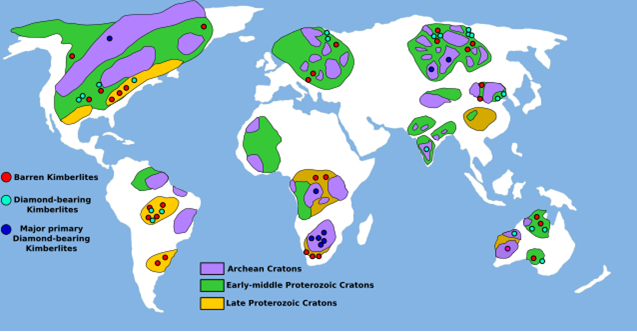
Kimberlites Rocks are the most important source of diamonds in the world. 6,400 kimberlite pipes have been discovered in the world, of those about 900 have been classified as diamondiferous pipes, and of those over 30 have been economic for Diamond. The Kimberley, South Africa, was the first recognized and the source of the Diamond. The Kimberley diamonds were originally found in weathered kimberlite. In the 19th century, a flood of diamonds was found in Kimberley. Lamproites have been recognized in over 25 occurrences on all
continents. The formation of both kimberlite and lamproite magmas has occurred from the Precambrian to the Cenozoic, although the Mesozoic Era was the time of most frequent kimberlite emplacement, and the Cenozoic Era was the most frequent lamproite formation. Lamproites are dominantly characterized by extrusive forms, whereas kimberlites mostly occur as intrusive diatremes, hypabyssal root zones, and dikes.
Carbon and Kimberlite Rocks
Diamonds form in the molten rock of the Earth’s mantle about 161 km below the Earth’s surface. This depth provides the right amounts of pressure and heat to transform carbon into a diamond. In order for a diamond to be created, carbon must be placed under at least 435,113 pounds per square inch of pressure at a temperature of at least 400 degrees Celsius. If conditions drop below either of these two points, graphite will be created. At depths of 150 km or more, pressure builds to about 725,189 psi and heat can exceed 1,200 C. Most diamonds that we see today were formed millions of years ago and Powerful magma eruptions brought the diamonds to the surface, creating kimberlite pipes.
